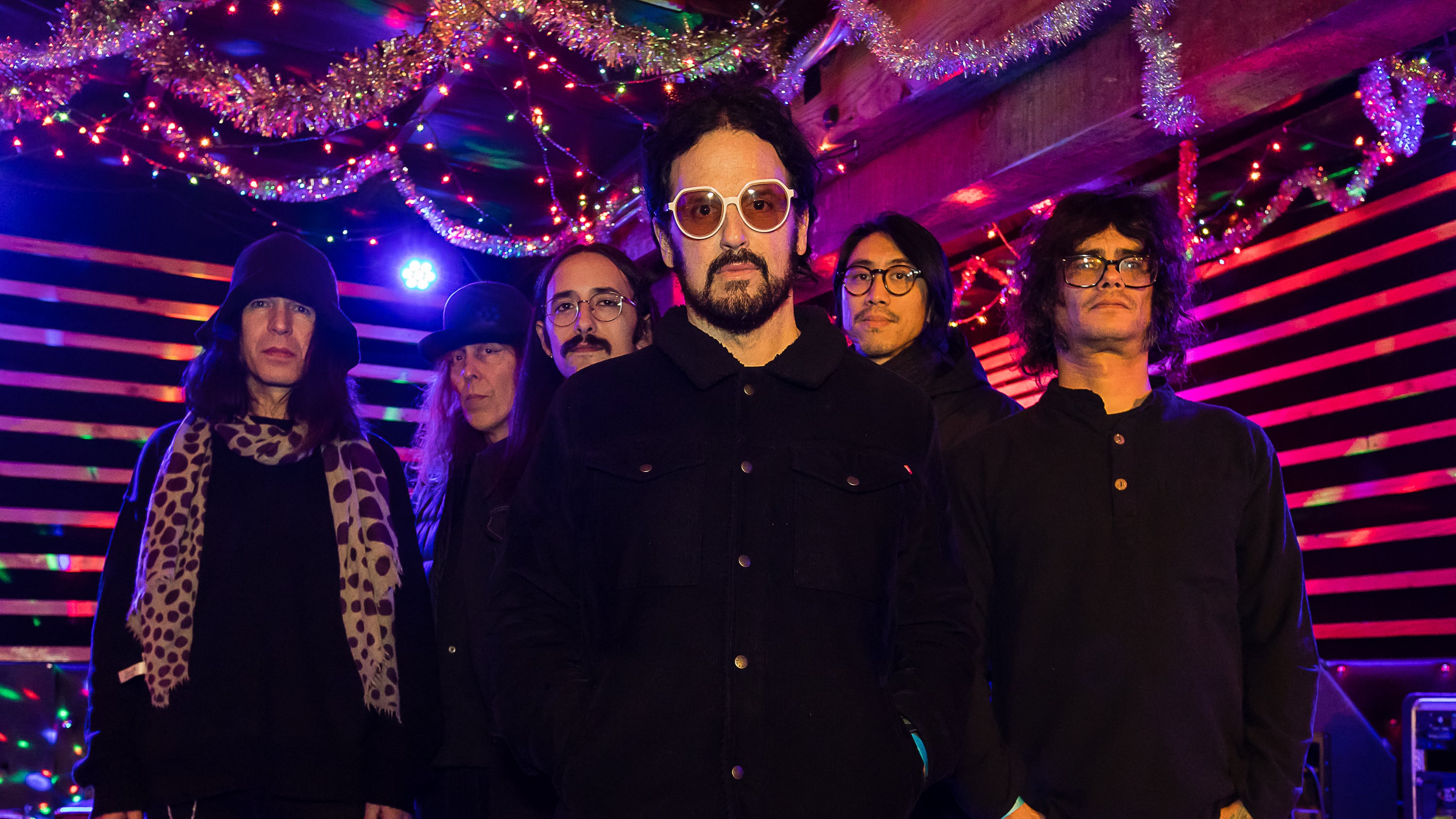Psych-rock shaman and starry-eyed shoegazer, Jsun Atoms never had much time for a solo album.
Atoms’ groups (The Bella Low, The Upsidedown, Daydream Machine) have shared the stage with just about every relevant contemporary and soundtracked a daunting array of film and television, ranging from True Blood/Ray Donovan/Sons of Anarchy to last year’s trending festival favorite Neolovismo. After a quarter-century leading combos ‘round Portland, a global pandemic found the frontman unencumbered and with little else to do beyond tinker with past compositions at the studio of longtime friend Peter Holmstrom, the Dandy Warhols’ co-founding guitarist and Atoms’ bandmate in ongoing side project Pete International Airport.
Globally acclaimed as a psychedelia masterclass since its late 2021 release, the star-studded, Holmstrom-produced Sun Atoms debut record Let There Be Light led Adams to assemble another outfit for live gigs. It soon evolved into a fully-functioning band all its own—also called Sun Atoms. Depending on Holmstrom’s touring duties for the Dandy Warhols, Atoms hopes to have the group’s sophomore release finished this summer, and he’s already scheduled a spring trek through California following their second appearance at Boise’s annual Treefort Music Fest.
As things stand, the band’s last performance for some time will occur this Saturday evening to kick off New Year’s Eve’s Eye Ball—a celebration of the surreal through art, music, and dance headlined by DJs Gregarious and Rescue (aka Holmstrom’s fellow Dandy, Zia McCabe). Awaiting their final show of 2022, Atoms spoke to WW about the challenges of translating pandemic production to live concerts, the rewards of working with a trusted projectionist, and the unending wonders of personalized distortion pedals.
WW: How did Sun Atoms come about?
Jsun Adams: Basically, when the pandemic hit, I just started going into the studio with Pete [Holmstrom] a few times a week. I had, like, eight or ten songs that I’d been toying with in different bands over the years. Some of them were from last year. Some were 20 years old. So, you know, let’s lay em down and see what happens, right?
So, availability of strings and horns aside, why did the old songs sit around for decades?
That’s a good question, man. It definitely wasn’t from a lack of trying, but sometimes songs just don’t work. Pete’s so open, though. Working with him, he’s not interested in any genre per se. He just wants to make music that he’s never heard before using a combination of samples and pedals. There’s this song called “Half Robot Half Butterfly” where he put, like, 40 guitars?
Did you see this as more career retrospective or sampler for what comes next?
So, it started off as just a studio project — something to do during the pandemic — and making [the album] felt a little bit like artistic survival. Daydream Machine had been over for about a year, I think, and I’d been working on a project called Mother Mariposa with a friend from New Zealand. He actually ended up having to move back at the start of COVID. Things just kind of worked out that way.
Then, as things were developing and we started working out ideas about who would make the videos or how we’d put it out, everybody we sent a record just seemed to want to be involved somehow. There was this really positive hum.
One cool thing about the pandemic? Everybody had their own home studios so, like, we were able to do the first song of the album as a collaboration with Alex Maas from the Black Angels. After we sent the track down to Austin, he wrote the chorus and added Mellotron. We sent a couple of the other tracks to a friend in Brooklyn band The Vandelles who added some really cool backing vocals. We sent another track to Sacramento where our friends in this punk band Pets did some cool vocal stuff. Someone we never had in the studio did strings, and we also had trumpets and saxophones and a whole horn section.
And, as engineer?
Stephen Street, yeah! He did, you know, all the big Blur albums, Morrissey’s first album, the last two Smiths …
I’d been thinking that we should go outside of the usual people around town, and Pete said, since we might have a great record on our hands, we should see who’d be interested in mixing it. So, OK, I looked inside some of my favorite albums, made a list of my favorite producers, and tried sending them the tracks. Stephen Street was one of them, and he asked to hear some more. This is the guy who engineered The Queen Is Dead and started Blur’s whole career! High school me was just pinching myself.
***
When you were recording the album, was there any expectation of one day playing the songs on stage?
Funny you should say that. When we were recording, I remember thinking we’ll probably never be able to do this live.
And, then, you spend the last year on tour …
Yeah, right? There were some cool highlights, though. We opened for Fishbone, toured with Modest Mouse on the Pacific NW leg, and played some of my favorite venues: Doug Fir, Mississippi Studios, Star Theater.
When it was getting mixed, the pandemic was … not ending, but at the point where you could play shows if you were vaccinated and masked. I’d had a couple of people in mind that I wanted to play with for years, and I started asking them if they wanted to join me and Pete on this project. June Kang, who’s been in several bands, said that he was trying to stay away from guitars and focus on sampling and beats. That was just perfect.
Another friend, Derek [Spencer], had moved here from Boise. He’s a cool guitarist in the realm of classics like the Animals, but he adds these strange layers on top of a real roots style kind of like Dead Meadows. Someone built him a distortion pedal with a combination of effects. It doesn’t have a name. It doesn’t have any markings. I’m not even sure what it does besides push stuff all the way out there.
And the horn section?
Mars de Ponte. He actually plays live with us now.
Which horn does he prefer during shows?
All of them. When we’re on stage, look for all the stands. There’s a piccoletto, a bass clarinet, a bass saxophone – saxophones of every shape and size. He’ll switch back and forth between different horns on the same song. A couple of the tracks are slower, like Bad Seeds, and we try to make those cinematic. When he’s trumpeting, there’s a nod to Morricone or almost a Federale feel, and he manages to have some of the part sound almost Arabian?
Different than on albums?
JA: The band arrangements add a lot. Probably, the hardest time we had was syncing the MPC — learning how to play in time along with some of the samples from the album. It feels like second nature now, but there were definitely some growing pains the first few months.
***
You now consider Sun Atoms a fully functioning band, yeah?
Definitely.
Was there a point where that coalesced?
Um, boy, let’s see — we’re just one year old as a band. Maybe when Derek introduced one of his own songs, which we’ve been ending our sets with since July? That felt, like, ‘wow, this is really working.’ After a year of just doing the songs that Pete and I wrote in studio, it’s really fun to be working on an album as a band, and the guys have been great. The [recordings] are linked, but the new stuff definitely has more of a live feel and group vibe.
Do you still incorporate a visual element?
Yeah, Trey Schultz usually does our projections. On the video for “The Cat’s Eye”, the song with Alex Maas, we worked with this writer/director/animator based in Rome named Susanna Della Sala, and, when we play the song live, he basically shows her cartoon — her drawings — from the video. It has some really cool and surrealistic nods to dreams versus reality. We’re always looking for some unnerving illogical themes, and using the imagery she created has been a really powerful way to start our sets. That was the first song we sent out, and she spent about five months making the video. We were so lucky to get her.
We had another video done for “Don’t Take Me To Your Leader” that’ll be projected. [Mississippi Studios marketing director/ex-WW music editor] Casey Jarman took the idea of a single cell organism morphing into a bird creature and back again and did all that over kind of goofy actual Portland backdrops.
Other than those two songs, I love what Trey does. He has vision and taste, and I just try to stay out of his way. If he uses something, like a movie combined with a gel or a face crossed with fire, he always makes it his own. That way, you’re never seeing the same things. He’s moving and changing with the music. And, he’s also a great lighting designer. For the Modest Mouse tour, we didn’t have the option of projections because of the timing that goes along with being an opening band and the throws for bigger rooms were just too long, but he still did an amazing job on the lighting. Each night, he spent a few hours figuring out how the house boards worked and what he could do to make it pretty up on stage. Very cool.
What we do isn’t jazz, I say surreal too often, but sometimes with the horns and the riffs and the projections there’s this kind of compelling nuclear mysticism that feels on the verge of transcending. Pete has this amazing pedal drawer too, and he’s working in tune with June to strip away all of the ordinary. There’s a lot of colors to the sound.
GO: The Eye Ball, a New Year’s Eve surrealist dance party, features DJ Gregarious, DJ Rescue and Sun Atoms. Polaris Hall, 635 N Killingsworth Court. 8 pm Saturday, Dec. 31. $25.

